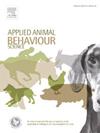Investigating the relationship between canine training classes and post-adoption return rates in North American shelters
IF 2.2
2区 农林科学
Q1 AGRICULTURE, DAIRY & ANIMAL SCIENCE
引用次数: 0
Abstract
Although millions of pets are adopted from shelters each year, a significant portion are returned after adoption which can have negative implications for pets and animal shelters. Previous studies indicate a strong correlation between behavioral issues and returned shelter dogs. The aim of this study was to investigate the relationship between attending post-adoption training classes and return rates. The study also looked at the distribution of return reasons between dogs who attended training and dogs who did not. Retrospective data between April 1st 2023 and March 31st 2024 was collected from three different shelters in North America (Seattle, WA; DeKalb, IL; Edmonton, AB). Of all the adopted dogs (n = 3325), we looked at which dogs attended training (n = 204) and used propensity score matching to generate a matched control group of dogs who did not attend training. The control group was matched based on age, sex, breed, shelter and intake type. The results showed no significant difference in return rates between dogs who attended training (8.3 %) and dogs who did not attend training (9.3 %) as analyzed by Pearson Chi Squared test (X2(1) = 0.122, p = 0.727). However, of all the returned dogs, those who attended training were more likely to be returned for owner-related reasons (58.8 %), whereas dogs who did not attend training were more likely to be returned for animal-related reasons (78.9 %, X2(1) = 5.386, p = 0.020). While attending training classes at animal shelters may help to reduce behavioral returns, as shown by the shift in return reasons, they do not appear to reduce return rates significantly for the general shelter population. This finding provides valuable insight for shelters to improve their resource allocation. Shelters can have a more targeted approach by providing behavioral support for dogs that are at high-risk of return, thus setting those dogs up for a greater likelihood of permanent adoption.
在北美收容所调查犬类训练班和收养后返回率之间的关系
虽然每年有数百万的宠物被从收容所收养,但很大一部分在被收养后被送回,这可能对宠物和动物收容所产生负面影响。先前的研究表明,行为问题与返回收容所的狗之间存在很强的相关性。本研究旨在探讨参加领养后训练课程与领养回复率的关系。该研究还研究了参加训练的狗和没有参加训练的狗之间回归原因的分布。2023年4月1日至2024年3月31日期间的回顾性数据收集自北美三个不同的避难所(华盛顿州西雅图;伊尔迪卡尔布;埃德蒙顿,AB)。在所有被收养的狗(n = 3325)中,我们观察了哪些狗参加了训练(n = 204),并使用倾向得分匹配来生成一个匹配的对照组,这些狗没有参加训练。对照组根据年龄、性别、品种、住所和摄入类型进行配对。Pearson χ 2检验结果显示,参加训练的狗与未参加训练的狗的回归率(8.3 %)无显著差异(X2(1) = 0.122,p = 0.727)。然而,在所有返回的狗中,参加过训练的狗更有可能因与主人有关的原因被返回(58.8% %),而未参加训练的狗更有可能因与动物有关的原因被返回(78.9% %,X2(1) = 5.386,p = 0.020)。虽然在动物收容所参加培训课程可能有助于减少行为返回,正如返回原因的变化所显示的那样,但它们似乎并没有显着降低一般收容所人口的返回率。这一发现为庇护所改善资源分配提供了有价值的见解。收容所可以采取更有针对性的方法,为回归风险较高的狗提供行为支持,从而使这些狗更有可能被永久收养。
本文章由计算机程序翻译,如有差异,请以英文原文为准。
求助全文
约1分钟内获得全文
求助全文
来源期刊

Applied Animal Behaviour Science
农林科学-行为科学
CiteScore
4.40
自引率
21.70%
发文量
191
审稿时长
18.1 weeks
期刊介绍:
This journal publishes relevant information on the behaviour of domesticated and utilized animals.
Topics covered include:
-Behaviour of farm, zoo and laboratory animals in relation to animal management and welfare
-Behaviour of companion animals in relation to behavioural problems, for example, in relation to the training of dogs for different purposes, in relation to behavioural problems
-Studies of the behaviour of wild animals when these studies are relevant from an applied perspective, for example in relation to wildlife management, pest management or nature conservation
-Methodological studies within relevant fields
The principal subjects are farm, companion and laboratory animals, including, of course, poultry. The journal also deals with the following animal subjects:
-Those involved in any farming system, e.g. deer, rabbits and fur-bearing animals
-Those in ANY form of confinement, e.g. zoos, safari parks and other forms of display
-Feral animals, and any animal species which impinge on farming operations, e.g. as causes of loss or damage
-Species used for hunting, recreation etc. may also be considered as acceptable subjects in some instances
-Laboratory animals, if the material relates to their behavioural requirements
 求助内容:
求助内容: 应助结果提醒方式:
应助结果提醒方式:


